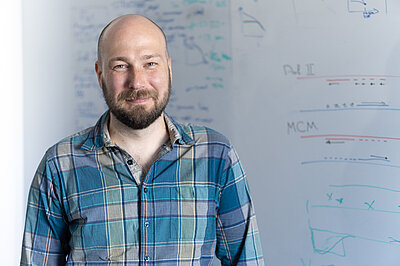ERC Starting Grant for Anton Goloborodko
The European Research Council (ERC) has awarded Anton Goloborodko, Junior Group Leader at IMBA, a Starting Grant for his project on homology search in DNA repair. The ERC Starting Grant is the most prestigious European research grant for early career scientists. The funded project is the next step in the Goloborodko Lab’s ongoing research into the biophysics of DNA structure.
Both environmental and biological factors can damage DNA, leading to the loss of important genetic material. To preserve genetic information, cellular DNA repair mechanisms seek to quickly and effectively repair DNA damage. One of these mechanisms is the so-called Homology-Directed Repair (HDR). HDR uses a homologous copy of the damaged site as a template for accurate repair.
“During HDR, the damaged DNA region is recognized and stabilized by the repair machinery, which forms a large protein complex,” Goloborodko explains. However, the next step in HDR is poorly understood: “We don’t know how the repair machinery then manages to quickly comb through the enormous and tightly packed genome to find the homologous template and bring it close to the damaged site.”
In the last years, different theories have been developed to explain the unknowns of the HDR process. “Different theories propose that the thermal-based diffusion of molecules or the rearrangement of the DNA by molecular motors could explain how the homologous template reaches the damaged DNA site, but these theories haven’t been proven yet,” Goloborodko explains.
In the newly funded ERC project, the Goloborodko group will apply their biophysics and computational biology knowledge to develop new physics-based computational simulations. “Using these simulations, we will test which of these theories agree with what we know about the structure and mechanics of chromosomes, focusing on how the damaged DNA site and the rest of the DNA move within the complex nuclear environment.” Goloborodko explains. By altering the forces in their simulations and adjusting their parameters, the team will be able to predict the effect of various biological factors in the homology search process key to HDR.
The last years have brought incredible advancements in the field of DNA structure. New technologies like Hi-C have allowed scientists to measure DNA structure to an unprecedented degree. At the same time, technical advances, like those led by Daniel Gerlich at IMBA, now enable scientists to simultaneously study the folding of both copies of the same chromosome. “The data and ideas produced by these research teams have expanded our understanding of DNA folding, and thus our ability to simulate it,” Goloborodko explains.
Goloborodko and his team aim to harness the power of these advancements: “We want to translate these findings into vertebrate cells to find the last clue for understanding HDR,” Goloborodko remarks. “For this, we will study the movement of the damaged DNA site at all possible scales – from the microscopic motion along DNA fibers to large-scale rearrangement in the nucleus.”
The results of Goloborodko’s simulations will, in turn, provide a path for experimentally studying homology search during HDR. For this, Goloborodko will collaborate with various research groups at the Vienna BioCenter, including long-term collaborator Daniel Gerlich at IMBA, as well as David Hasselbach and Francesco Balzarotti at the Research Institute of Molecular Pathology (IMP). In addition, Goloborodko will collaborate with one of the worldwide experts in the field of HDR, Anjana Badrinarayanan at the National Centre for Biological Sciences (NCBS), India.
“Collaborating with these world-leading scientists will allow us to use cutting-edge technologies to experimentally test the ideas we propose, which was impossible before,” Goloborodko explains. “This will hopefully revolutionize our understanding of this key molecular process.”
